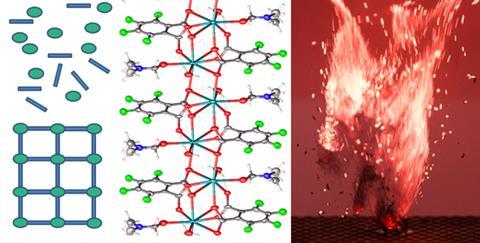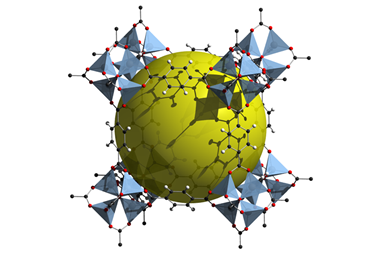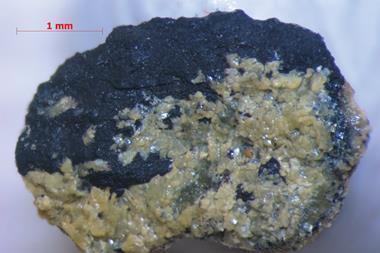Safe and simple scaffold gives consistent explosive mix

Scientists in the UK and Turkey have devised a new way to make explosive materials in a safer, simpler and more consistent manner.
Pyrotechnics are the energetic components of fireworks, flares, safety matches and even car airbags, but their manufacture has witnessed very little development, remaining archaic, hazardous and uncontrollable. Traditional mixing methods involve either sieving and tumbling of dry powders with irregular particle shapes and sizes or blending a slurry. Neither guarantees an ideal homogenous composition and both are plagued by batch-to-batch inconsistency.
Now, a team led by Simon Coles, from the University of Southampton, has devised a method that combines fundamental pyrotechnic components – a fluorinated oxidiser and an alkaline metal nitrate fuel – in a single crystalline functional material; a type of metal organic framework (MOF). The MOF provides a solid state lattice that ensures compete blending, thereby minimising batch variation.
Although MOFs have been used to trap or sense explosives before, Coles is keen to stress that this is the first time they have been employed with pyrotechnics. This new approach has numerous advantages: the materials are cheap, the synthesis is safe, relatively simple and should be easily scalable to a gram or kilogram level. The driver behind this work is the defence industry and Coles envisages drones carrying his MOFs for signal flares, smoke screens and decoys.
Explosives expert Nigel Davies, previously at Cranfield University in the UK, says this approach is relevant to applications where small quantities of material must produce a very precise effect. ‘There is much interest in formulations that can react violently in very small [<1 g] quantities to initiate detonation as replacements for most of the primary explosives that are still in service.’
However, Davies adds that the pyrotechnic properties of these MOFs aren’t yet completely clear. The next step is therefore to fully characterise the MOFs in terms of their physico–chemical properties, such as friction and sensitivity.
As the MOFs are not very porous, Coles hopes to look at including bigger pores and more space in the lattice to load other components; one idea is organic dyes to impart an improved and tailorable colour effect for fireworks. And although Industry has bulk processes for producing some pyrotechnic materials, Coles says his work could transform the way specialist materials are made: ‘Thinking about materials for the future with more bespoke requirements, I think we are looking at something that has an awful lot of potential impact.’
References
This article is free to access until 18 August 2015. Download it here:












No comments yet